November 15, 2024
Air Date: November 15, 2024
FULL SHOW
SEGMENTS
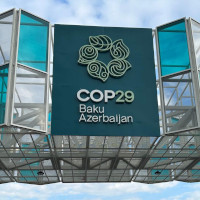
29th UN Climate COP Kicks Off
View the page for this story
Delegates from nearly 200 countries are meeting in Baku, Azerbaijan for the UN Framework Convention on Climate Change’s 29th Conference of the Parties. Alden Meyer of the climate think tank E3G is a longtime observer of these meetings, and he joins Host Paloma Beltran to share his first impressions as these talks kick off. (11:55)
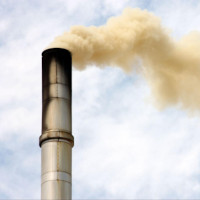
Earth’s Fever
View the page for this story
Although the global average temperature has been steadily increasing for decades, in 2023 there was a sudden jump of 0.2 degrees Celsius. This has raised alarm among climate scientists about how fast the climate crisis is progressing. Dr. Jennifer Francis is Senior Scientist at the Woodwell Climate Research Center, and she joined Living on Earth’s Jenni Doering to discuss the temperature spike and its implications. (11:02)
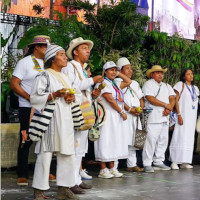
A win for Indigenous Groups Protecting the Planet
View the page for this story
This year’s 16th meeting for the UN Convention on Biological Diversity was suspended as negotiations ran overtime and delegates needed to catch flights home. But earlier in the talks, a decision was reached to give indigenous communities a proper seat at the table moving forward. Carmen Rosa Guerra Ariza is delegate from one such indigenous community, the Kankuamo people, and she joins Host Aynsley O’Neill to discuss this win. (09:00)

BirdNote®: Great Tinamou
/ Mary McCannView the page for this story
The jungles of Colombia are home to a bird with a haunting call. BirdNote’s Mary McCann reports. (01:50)
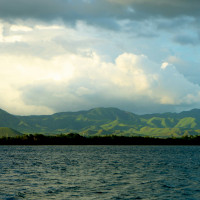
Puerto Rico’s Solar Power Problem
View the page for this story
After Hurricane Maria destroyed Puerto Rico’s power grid in 2017, much of the island was left without electricity for up to a year, leaving vulnerable populations in the lurch. Many Puerto Ricans are pushing for a reliable, sustainable electricity system, but a proposed utility-scale solar project has sparked concerns. Ruth Santiago, an environmental attorney who serves on the White House Environmental Justice Advisory Council, joins Host Paloma Beltran to discuss the future of solar energy in Puerto Rico. (13:13)
Show Credits and Funders
Show Transcript
241115 Transcript
HOSTS: Paloma Beltran, Aynsley O’Neill
GUESTS: Carmen Rosa Guerra Ariza, Jennifer Francis, Alden Meyer, Ruth Santiago
REPORTERS: Mary McCann
[THEME]
O’NEILL: From PRX – this is Living on Earth.
[THEME]
O’NEILL: I’m Aynsley O’Neill.
BELTRAN: And I’m Paloma Beltran.
Nations gather for this year’s UN climate summit where time is running out to meet key goals.
MEYER: This is a daunting prospect. We are basically trying to reengineer the entire economic operating system of the planet in a matter of decades, which is unprecedented in human history. So, we shouldn't be surprised that it's not easy.
BELTRAN: Also, Puerto Ricans look for sustainable and equitable solutions to chronic power outages.
SANTIAGO: Puerto Rico does not need to be a place of unmitigated disaster. We can have a very viable electric system that provides energy security and allows for this to be a livable place, basically, where people can live and work and otherwise prosper.
O’NEILL: That and more this week on Living on Earth—stick around!
[NEWSBREAK MUSIC: Boards of Canada “Zoetrope” from “In A Beautiful Place Out In The Country” (Warp Records 2000)]
[THEME]
29th UN Climate COP Kicks Off
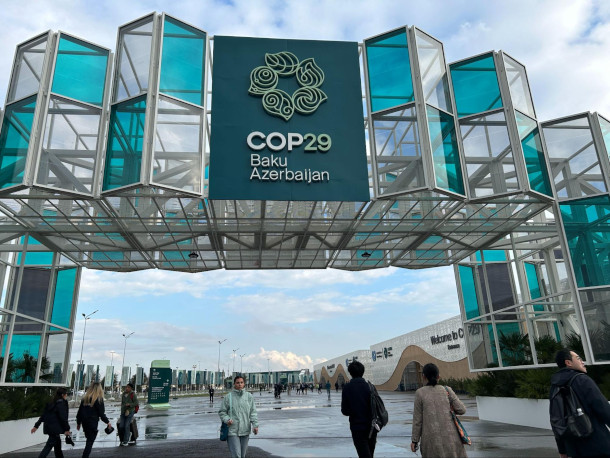
In Baku, Azerbaijan, delegates from nearly 200 countries gather for the UN Framework Convention of Climate Change’s 29th Conference of the Parties, or COP29. (Photo: IRENA, Flickr, CC BY-NC-ND 2.0)
O’NEILL: From PRX and the Jennifer and Ted Stanley Studios at the University of Massachusetts, Boston, this is Living on Earth. I’m Aynsley O’Neill.
BELTRAN: And I’m Paloma Beltran.
In Baku, Azerbaijan, delegates from nearly 200 countries have gathered for the UN Framework Convention on Climate Change Summit, also known as 29th Conference of the Parties, or COP29. The host country itself is a petrostate where oil and gas production yields more than 90% of its export revenues and nearly half of its GDP.
And notably absent from the climate talks are top leaders from high polluting countries like the US, Brazil, China, and India. Meanwhile the climate crisis is intensifying, and time is running out to meet the goals set by the twenty-fifteen Paris Climate Agreement. Alden Meyer of the climate think tank E3G is a longtime observer of these meetings, and he joins us now from Baku to share what he’s hearing. Welcome back to Living on Earth, Alden!
MEYER: Good to be with you again, Paloma.
BELTRAN: So, what's the mood like at the opening of COP29 in Azerbaijan?
MEYER: Well, it's a little tense, because they have a big decision to make at the end of next week, which is how to set a new finance goal to replace the 100 billion dollars that's been in place for the last five years that was pledged by the US, Europe and other developed countries back in 2009 in Copenhagen. And of course, the need is much greater than that, and developing countries are insisting that developed countries come up with much greater sums of money on the table. And of course, the election last week of Donald Trump in the US has raised questions about whether the US can even participate in that at all, and if so, what does that mean for Europe and others.

The incoming Trump administration has cast doubt on the United States’ ability to participate in international climate negotiations. US delegates insist they will keep fighting. (Photo: Gage Skidmore, Flickr, NC BY-SA 2.0)
BELTRAN: Yeah, so, let's talk about the US. How are US delegates at COP29 addressing the recent election and for that matter, how are the other nations reacting to a second Trump presidency?
MEYER: Well obviously the US delegation here is continuing to pursue their negotiating brief, their mandate. John Podesta is here as the senior member of the delegation. He did a press briefing yesterday where he insisted that they would continue to fight for what they've been pushing for over the last four years in these negotiations. He also tried to reassure the world that actions by states, cities, businesses and others would fill some of the vacuum created by what President-elect Trump is likely to do once he takes office to the federal program that they've been building. He also talked about how there's Republican support for elements of the Inflation Reduction Act, particularly the tax incentives for companies to invest in clean technologies. But people here are quite nervous about that. They understand that President Trump is likely to pull out of the Paris Agreement on day one, not to take six months like he did last time. They're also quite concerned about what he will do back at home, and what that means for the US ability to pull our share when it comes to emissions reduction, and particularly they're very aware that the last time he was in office, he tried to virtually eliminate US financial assistance for developing countries to decarbonize their economies and to deal with the mounting impacts of climate change. Of course, the last time the Congress, including the Republican Senate, kept him from getting everything he wanted, and they preserved a fair amount of that finance. There's concerns that might not be the case this time around, and what does that mean for the future?
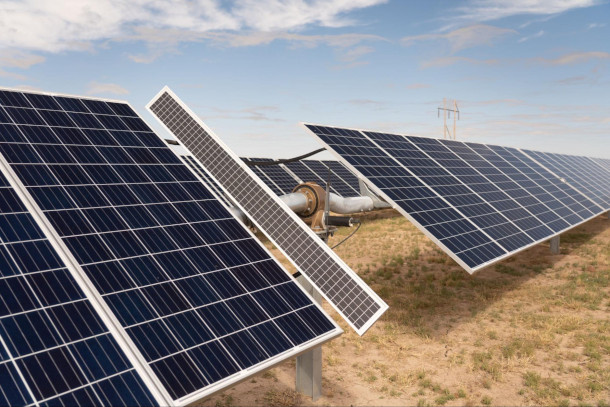
A new global climate finance goal is supposed to be negotiated by the end of COP29. Developing nations are pushing for a number in the trillions of dollars. (Photo: Jonathan Cutrer, Flickr, CC BY-NC 2.0)
BELTRAN: So, you mentioned that developing nations are hoping to reach a new global climate finance goal by the end of this COP. How much is needed to fill that gap, and to what extent is the world making a dent there?
MEYER: Well, there's pretty broad agreement on the overall need for developing countries that we need in the trillions of dollars, if we're going to address both decarbonizing their economies, converting to clean energy, dealing with deforestation, etc., if we're going to deal with adaptation investments and building resilience to the impacts of climate change, and that's not to mention what's called loss and damage, which is helping countries that are reeling from the current impacts of climate change. Trillions of dollars is not what's being discussed here by the developed countries. They are talking about much more modest increases over the existing 100 billion dollar a year goal. And of course, that's the big question, is, what will they come out of here next week with. It's complicated by the fact that the developed countries all insist that some of the wealthier developing countries, the Gulf states, like Saudi Arabia, the UAE, Singapore, South Korea, even China, participate in this next round of climate finance, and that they contribute as well. That is being actively resisted by the developing countries. They say that's renegotiating the agreement. And then, of course, there's also the question of what counts towards that number, whatever number they come up with. There starts to be controversy when you get into the area of private sector finance. And of course, there's a lot of concern with some countries about carbon markets, carbon offsets, that whole kind of area. And it's kind of strange that 30 years into this regime, we don't have agreement on what counts and doesn't count, but that's where we're at. You've got to remember that the original $100 billion commitment was not negotiated by countries. It was put on the table unilaterally by the US, UK, Europe, other developed countries in Copenhagen in 2009, and so this is the first time that we're actively having a negotiation over these issues in the treaty process.
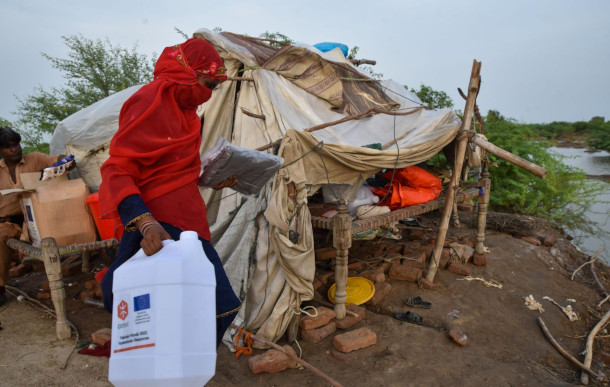
Floods in Pakistan in 2022 cost an estimated $30 billion in damage. Promises of $800 million for global loss and damage are negligible compared to the need of many developing nations experiencing the brunt of climate change effects. (Photo: EU Civil Protection and Humanitarian Aid, Flickr, CC BY 2.0)
BELTRAN: And Alden at last year's club, $700 million were pledged to assist developing countries with loss and damage. That was one major part of the global climate finance picture. As it stands now, who are the top contributors to loss and damage funds and who is maybe shortchanging those developing countries?
MEYER: Well, I mean, the leading contributors last year towards that $700 million, which now is, I think, a little over $800 million were the United Arab Emirates, which was the host of the COP, and Germany. They put in $100 million each. A number of other European countries put in money. The US was only able to come up with 17 and a half million dollars that they could mobilize from existing funds that Congress had already approved. That was seen as wildly inadequate. And of course, you've got to contrast that $800 million with the acknowledged need of tens or even hundreds of billions of dollars a year. For example, just before the COP last year that Pakistan was undergoing extreme flooding. The damages in that one country alone were estimated at $30 billion. So, $800 million, it was a good faith effort, but it's a drop in the bucket. And I also point out that you have to contrast that $800 million that was raised at COP28 last year for loss and damage with the three and a half billion dollars a day that countries are still spending to subsidize production and consumption of fossil fuels. That's kind of the definition of insanity. You're paying people to produce and burn something that you say is an existential threat to humanity, and yet we're doing over a trillion dollars a year going to subsidize fossil fuels.
BELTRAN: Alden, what other urgent topics of conversation are you hearing at this COP?
MEYER: Well, of course, everyone was talking about adaptation and impacts. We've seen, as you know, unprecedented devastation across the world this year, not just in the US, but the flooding that we've seen in Brazil, the recent flooding in Spain and in Colombia, drought and other regions. So this is really hitting home, and people are saying, we not only have to accelerate our efforts to reduce emissions of the heat trapping gasses that are driving this problem, but we have to cope with the rising impacts of climate change that are gonna continue to get worse over the next several decades, even if we're able to quickly wean ourselves off of fossil fuels. So that's getting a lot of attention here, driven by the reality of devastating climate impacts that most countries are now experiencing.
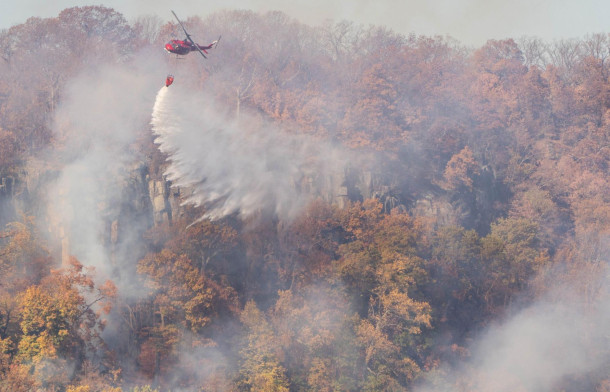
Wildfires erupted across the eastern US this fall as drought conditions persisted. Support for adaptation to climate change effects is another crucial topic of conversation at COP29. (Photo: Anthony Quintano, Flickr, CC BY 2.0)
BELTRAN: So, recent scientific reports warn that current national plans put us on track to warm the planet by around three degrees above pre-industrial levels. You know, that's far higher than the 1.5-degree goal. What can be done at this COP to get some actual movement towards that goal?
MEYER: Well, as you say, we're nowhere near on track to meet the 1.5 target. And of course, in 2018 the Intergovernmental Panel on Climate Change, which is the world's premier scientific body looking at this, said there was a tremendous difference in impacts between a 1.5-degree world and even a two-degree world. A three-degree world is horrific. I mean, it's really destabilizing and catastrophic, and everyone agrees that we need to do a lot more to close that gap. That's what we're looking for over the next months, into 2025 when it is time for countries to put their next round of commitments on the table under Paris. The current commitments go out to 2030. The next round are going out to 2035, and that will really determine whether or not we have a fighting chance to meet even the two degree target that countries set well below two degrees at Paris. And of course, we can already say that it's unlikely that this next round of commitments under Paris is going to be adequate. So, the host of the COP next year is Brazil, and they are going to have to grapple with, what do we do when what countries have put on the table doesn't add up, and they've got to insist this is not your final answer. You've got to go back and do more. You've got to ramp up sectoral ambition in areas like the power sector or deforestation or methane emissions or land use and agriculture. You have to work with your cities and your states and your companies and the other so called sub national actors to ramp up their ambition. So, there's gonna be a lot of work still to do after this next round of commitments. And I think the good news is Brazil understands that, and they're starting to lay the groundwork to, to make that happen next year, but this is a daunting prospect. We are basically trying to re-engineer the entire economic operating system of the planet in a matter of decades, which is unprecedented in human history. So, we shouldn't be surprised that it's not easy.

Alden Meyer is a Senior Associate at E3G working on US and international climate policy and politics. He is a Principal at Performance Partners, which provides a range of consulting services to clients in government, business, and the non-profit sector. (Photo: Courtesy of Alden Meyer)
BELTRAN: How crucial is it for progress to be made at COP29?
MEYER: Well, clearly, we need to make progress at every COP. I've said that over the years. This is a very important one in terms of finance, because it is the one where we decided we would try to agree on the post 2025 climate finance mobilization goal to replace the $100 billion. So that's important in two ways. It's important in terms of actually mobilizing greater sums of money to have an impact on the ground, but it's also important in terms of building confidence and trust in this process that it can deliver, that countries can work together across north, south lines, across regional differences, across all the conflicts that we're experiencing around the world, in the Middle East and Sudan and in Ukraine and other regions, and continue to cooperate on climate change, because we know when it comes to climate change, we're all in this together. We're all in the same boat. We can't afford to point fingers at each other and say, your end of the boat is sinking because we're all in the same boat.
BELTRAN: Alden Meyer is a senior associate of E3G, and he joined us from COP29 in Baku, Azerbaijan.
Related links:
- COP29 Home Page
- Learn more about E3G
[MUSIC: Chingiz Sadykhov, “Senden Mene Yar Olmaz” on Piano Music of Azerbaijan, 7/8 Music Productions]
O’NEILL: Just ahead, the science behind Earth’s “fever”. Stay tuned to Living on Earth.
ANNOUNCER: Support for Living on Earth comes from Sailors for the Sea and Oceana. Helping boaters race clean, sail green and protect the seas they love. More information @sailorsforthesea.org.
[CUTAWAY MUSIC: Chingiz Sadykhov, “Iran Mahnysy” on Piano Music of Azerbaijan, 7/8 Music Productions]
Earth’s Fever

Greenhouse gas emissions from the burning of fossil fuels have trapped an increasing amount of heat in the atmosphere, leading to a 1.2 0 Centigrade rise in average surface global temperature. (Photo: Ian Barbour, Flickr, CC BY-SA 2.0)
BELTRAN: It’s Living on Earth, I’m Paloma Beltran.
O’NEILL: And I’m Aynsley O’Neill.
Scientists monitoring earth’s climate have identified a concerning trend in global warming starting in April 2023. While climate change has been steadily heating up the planet for decades, in 2023 global average temperatures suddenly jumped by about 0.2 degrees Celsius and have remained elevated. The spike in temperature has raised alarm among climate scientists about how fast the climate crisis is progressing as they scramble to explain Earth’s worsening fever. Dr. Jennifer Francis studies climate and weather in the Arctic at the Woodwell Climate Research Center and has had her eyes on the planet’s rising temperature for decades now. She joined Living on Earth’s Jenni Doering to discuss the recent uptick in heating and what it could mean for the fight against climate change.
DOERING: So, let's start from the beginning. What's so abnormal about this temperature spike observed in the last couple of years that's raising concerns among researchers?
FRANCIS: Yeah, so there are many factors that come into play in creating both last year 2023 and again this year, breaking, really temperature records for the globe going back as far as we have records. So, we can estimate the temperature going back quite aways. And we're pretty sure that this past July in 2023 and then broken again in 2024 are really the warmest we've seen in many hundreds of years. So, this is quite concerning, and we know what's going on. I mean, the earth actually should be cooling right now, if it were only natural causes at play. But we know that, because we've been adding so many heat trapping greenhouse gasses to the atmosphere over the last several decades, that these heat trapping gasses are indeed keeping a lot more heat in the climate system than we should have right now. So, what's going on is that we're seeing some very large and intense marine heat waves in various parts of the global ocean, and those are the result of that heat being trapped by those greenhouse gasses. It gets stored in the ocean, about 90% of it goes into the ocean, and now we're seeing some of that heat coming back out and going into the atmosphere.
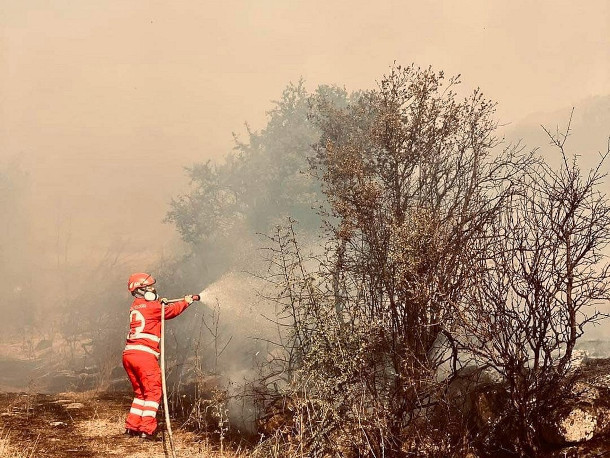
2023 was the hottest year on record and 2024 is set to be even warmer. Throughout the year, this intense heat has led to a number of natural disasters, including wildfires in Greece back in August. (Photo: Climate Center, Flickr, CC BY-NC 2.0)
DOERING: Now I understand that this spike in temperature is only about 0.2 degrees Celsius. That doesn't sound like much. Why does that number mean so much to climate scientists?
FRANCIS: Yes, well, it doesn't sound like much, and certainly any individual in any location would not really notice it. But in fact, this is a lot for the average over the entire globe. And if we look back at the natural fluctuations that have happened to the Earth's temperatures, going back 1000s of years, we know that it doesn't take very much to shift the globe from an ice age and the opposite, which we call an interglacial, this is a relatively warm period in the earth's temperature natural cycle. That's only three degrees Celsius difference. So, it really doesn't take a lot of temperature change in terms of absolute degree Celsius, to make a huge difference in what the climate system feels, what the living part of the Earth system feels. It can have huge impacts on things like weather and changes in ice and changes in plants and agriculture, because that small change in temperature globally gets translated to big changes in things like the atmosphere and ocean currents and things like that.
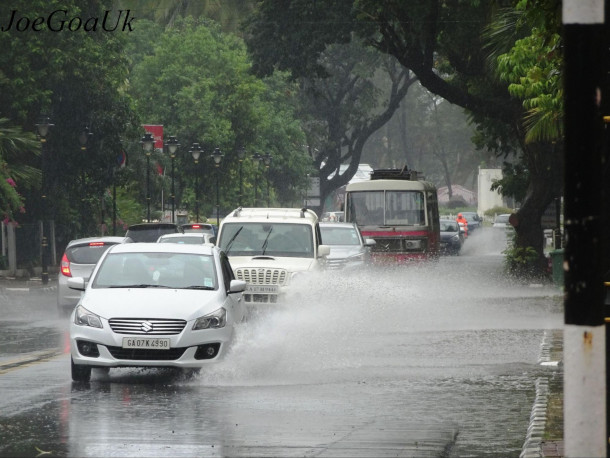
Flooding has become a regular reality for some cities and towns that are prone to heavy precipitation or coastal surges. (Photo: Joegoauk Goa, Flickr, CC BY-SA 2.0)
DOERING: What are some of the other theories or explanations that are being proposed for this recent temperature rise?
FRANCIS: Yeah, so this recent temperature rise is mainly caused by the increasing amounts of heat trapping greenhouse gasses that we've been putting into the atmosphere. That is the a number one cause, and the earth should be cooling right now, but instead, we're seeing this incredibly rapid increase in global temperatures and sea surface temperatures. So, some of the other factors that are playing a very much smaller role than the greenhouse gas increases are decreases in the amount of particles that are in the air that we've been putting in by burning fossil fuels, by forest fires, by volcanoes, by pollution from industry. So, there's been a decrease in the amount of those particles, and that plays a role, because those particles tend to reflect some of the sun's energy that's coming in, and that helps by having fewer of those particles, more of the sun's energy is making it into the climate system. So that's one minor role, also starting in April 2023 an El Nino started to develop. El Nino is basically a pattern of ocean temperatures that we see coming and going every few years, and we know that when an El Nino comes along, we tend to see increases in the global average temperature. And indeed, we saw that. But this is well beyond what an El Nino should do. Another potential cause, although I'd say the jury is still out, is the recent eruption of the volcano in Tonga, which is an island group in the South Pacific, and that put a lot of extra water vapor, moisture in the atmosphere. And water vapor is a greenhouse gas, so that potentially could have added to the greenhouse effect. But it's been generally shown that that effect is relatively small as well. So, really it comes down to the fact that we've been adding all of these greenhouse gasses to the atmosphere for decades by mostly burning fossil fuels, but also cutting down forests, removing mangrove trees along coastlines, getting rid of wetlands, all of these natural ways that the climate system can remove things like carbon dioxide from the atmosphere and help offset the effects of those heat trapping gasses.
DOERING: Sounds like things are really catching up with us.
FRANCIS: Yes, indeed. And this is not a surprise.
DOERING: Not a surprise, you say, but it sounds like there are climate scientists who are scratching their heads and saying, why are the numbers not lining up with what we expected? So, what's going on there?
FRANCIS: So, I would argue actually, that these numbers are not out of line with what we should have expected when we look at the simulations by these very complicated computer models that we use to project what the climate system is going to do. These models, they fluctuate just like the Earth's real climate does, around this trend line that's caused by the increasing greenhouse gasses, and those fluctuations in the model simulations are within the range of the spike that we saw last year and this year. So, it's really not out of the realm of expectations to see a spike like this. And in my mind, anyway, I don't think there's really a big surprise here.
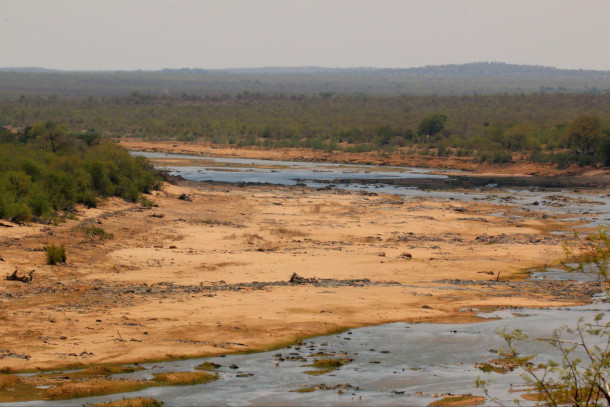
Higher levels of heat in the atmosphere cause more frequent and severe droughts, and intensify droughts linked to other causes. (Photo: Water Alternative Photos, Flickr, CC BY-NC 2.0)
DOERING: You know, the current national plans from governments to reduce carbon emissions would still result in around three degrees Celsius of warming, far more than the Paris Climate Agreement goal of 1.5 degrees C. So how does this recent temperature spike and this increase we're seeing long term relate to how nations should be thinking about their climate ambition?
FRANCIS: Yeah, well, you know these spikes in temperatures? Well, they're not surprising. They are kind of a wakeup call. And not just the temperatures, but the increases in extreme weather events that we've been observing increasing not only in the number of them, but how much damage they're doing, how intense they are, how much area they're covering, how many areas are being affected by these extreme events. So yes, heat waves are a big part of that, and connected to heat waves, often are droughts. We've seen some very severe droughts emerging and increasing, and both of those together are the recipe for wildland fires. We've seen a big increase in fires, which is a big concern, not because of the damage they do, but also because they release a lot more carbon containing gasses into the atmosphere, which just makes the whole global warming problem worse. We've seen yet another unprecedented flooding event unfolding in Spain, which follows on the heels of some incredible flooding that we've seen in our own country, here in Asheville, North Carolina, and up in Vermont and Maine and places that usually you think of being relatively immune to the major impacts of climate change. So, we have to really get on the stick here. The commitments that were made in Paris we knew were not going to be enough. But not only are we not meeting those insufficient targets, but we're falling behind even farther. And so, the expectation is that we'll blow right by the 1.5-degree target that was ambitious in Paris, but probably heading more towards three degrees. And we've already seen what these extreme events are doing, even with 1.2 degrees Celsius warming on average. So yeah, this is, I hope, a big wake up call for countries and for the public who vote for leaders who are making these decisions in these countries.
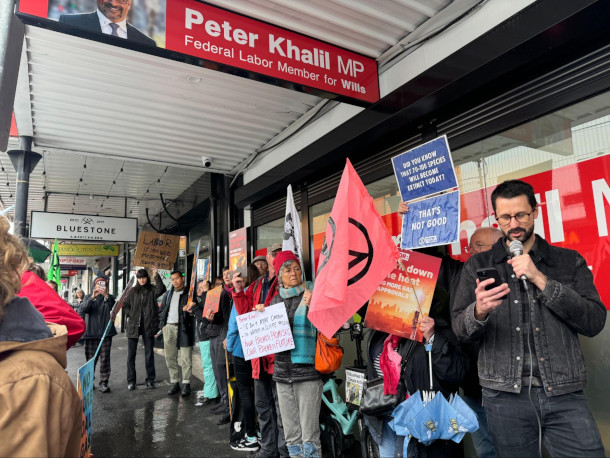
A protest of newly approved coal mines in Melbourne. (Photo: Flickr, John Englart, CC BY-SA 2.0)
DOERING: You've been studying this for decades now and sounding the alarm for quite some time. What keeps you going in this work? I mean, it must be tiring.
FRANCIS: Yes. I mean, every day you wake up and you read about another extreme weather event, because I study extreme weather, of course, that's what I pay attention to most closely. But what gives me hope to carry on is knowing that my research is helping communities understand what is possible in the future, what these extreme events are going to do in the future, and how they might affect various areas. I also see young people really charged up to figure out ways to reduce the severity of the climate crisis, and not just by becoming scientists or engineers, but by going into law, for example, and changing policy. People studying art that help the public understand in different ways, without just listening to the news and understanding the science, but reaching people through art, for example. Writers doing a better job of communicating the science, and also when an extreme event, like we were seeing recently, when those events happen, translating it better to the public to understand the fact that climate change is making these sorts of things more intense and more concerning. I mean, there's all kinds of ways for people to get involved. And to help make a difference. So, as we go forward, we can make this problem a little less bad.
O’NEILL: That’s Senior Scientist Jennifer Francis of the Woodwell Climate Research Center speaking with Living on Earth’s Jenni Doering.
Related links:
- Read about Dr. Jennifer Francis’ Research on the Arctic Climate
- Listen: Dr. Jennifer Francis’ comment on the 2023 Climate Record
- NASA | “NASA Analysis Confirms 2023 as Warmest Year on Record”
- World Meteorological Association | “2024 Is on Track to Be Hottest Year on Record As Warming Temporarily Hits 1.5°C”
[MUSIC: Oscar Peterson, “Stormy Weather” on Work from Home With Oscar Peterson, UMG Recordings, Inc.]
A win for Indigenous Groups Protecting the Planet
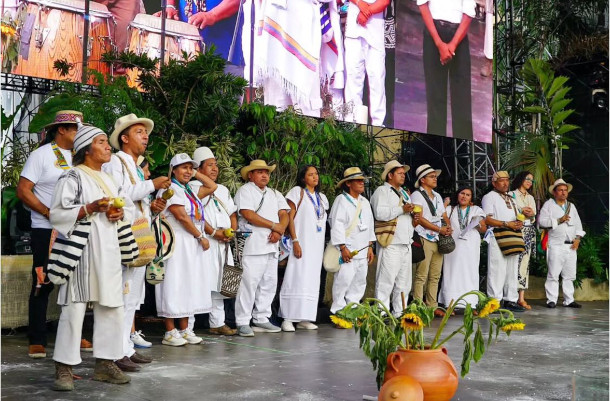
Kankuamo at COP16 in Cali, Colombia during the “viva paz con naturaleza” or the “peace with nature event”. (Photo: Courtesy of Carmen Rosa Guerra Ariza)
O’NEILL: As we reported last week the 16th conference for the UN treaty known as the Convention on Biological Diversity was suspended in disarray as the talks ran out of time to have a quorum. But early on, the negotiations yielded a landmark agreement to form a subsidiary body that specifically recognizes the role of Indigenous peoples in future conservation decisions. With indigenous peoples often known for their long and significant role in environmental conservation, this has been a fight for first nations groups worldwide. One such group is the Kankuamo people, who live in Colombia where the conference took place. Their ancestral lands are in the Sierra Nevada mountains, a place that is referred to as “the heart of the world” and is surrounded by a virtual border called the “Black Line” that connects over 300 sacred sites for the four indigenous nations that live there. Along with their neighbors, the Kankuamo people have dedicated much of their time and energy to protecting these lands, these days mostly from mining threats. For more, we turn now to Carmen Rosa Guerra Ariza. She serves as the Global Agenda Coordinator of the Indigenous Kankuamo Organization and joins me to share how her community is connected to the land and to reflect on this year’s biodiversity talks at COP 16. Carmen welcome to Living on Earth!
GUERRA: Thank you for having me and thank you all for allowing me to talk about my territory… And zuminjano, that means good morning in my language.
O'NEILL: Wonderful. So please tell us about your indigenous community, the Kankuamo.
GUERRA: The Kankuamo indigenous nation is one of four indigenous nations that live in the Sierra Nevada of Gonawindua, the heart of the world, the north of Colombia. We are being ancestrally protecting our territory that we believe that is the heart beating in the life system of the Mother Earth. And we are promoting the protection of the traditional spiritual sacred places that we have around the Sierra Nevada and that a half a name the Black Line. And the Black Line is the connection of those really specific spiritual places that protect the whole humanity for everything. And since we have knowledge, we have been doing that.
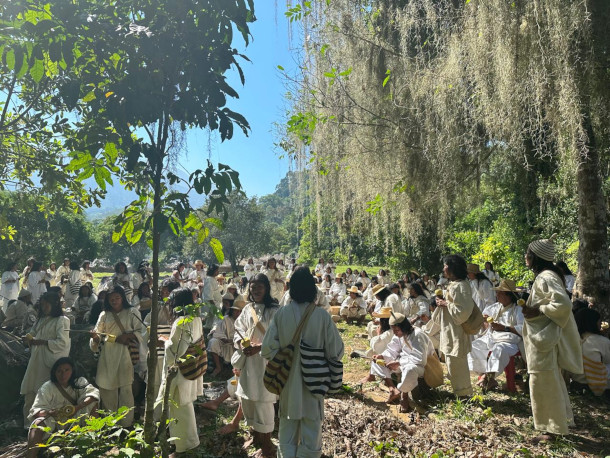
Kankuamo community gathering in their ancestral territory of the Sierra Nevada of Gonawindua. (Photo: Courtesy of Carmen Rosa Guerra Ariza)
O'NEILL: So, Carmen, could you tell us a little bit more about this term, the Black Line?
GUERRA: Of course, the black line is this series of sacred places that are around the Sierra Nevada of Gonawindua and that actually protect the Sierra Nevada of Gonawindua. Each of the sacred places have a purpose. For example, you have a place for healing. You had a place for knowing things. You can have a place for getting birth. You can have a place for, for many, many purposes. And the important part of these spiritual traditional places is that they need to be protected.
O'NEILL: So yes, you referred to the Sierra Nevada Mountains as the heart of the world. Where did that name come from?
GUERRA: Well, that is our traditional knowledge. So, we are basically protecting the heart of the world that is allocated there. It's not like we need to overthink about it, it is, it is. Since we exist in that territory, we are being protecting Mother Earth. So, we believe that we have nine worlds, four on top, four in the bottom, and in the middle is the earth. And all these words are connected in our traditional knowledge system. And that's why we know that the heart of the world is in our territory. It's the same, like the lung of the world. You know, the Amazon, in their traditional knowledge, they are protecting the lung of the world because they are allowing the Mother Earth to breathe through their territory.
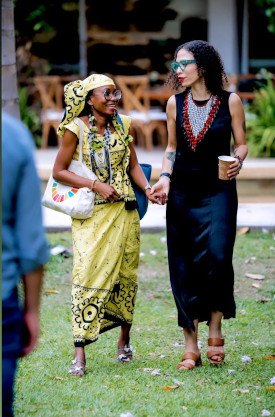
Hindou Oumarou Ibrahim (left), president of UN Permanent forum for indigenous issues alongside Carmen Rosa Guerra Ariza (right). (Photo: Courtesy of Carmen Rosa Guerra Ariza)
O'NEILL: And can you describe the Sierra Nevada for us? You know, what does it look like? And how does it feel to live there?
GUERRA: Well, it's not because it's my territory, but it's beautiful. It's the perfection itself. It have all the temperatures, so you have a snow in the top, and you have the beach at the bottom, so you can actually visit the top, and you are going to be with jacket, and then you are going to be in bathing suit because you are in the beach. But also, is really a specific each territory. We are four indigenous nations. So, we are all together protecting our territory, and we all have kind of the same tradition. So that's why we only have one traditional knowledge system. So, we are a really strong and resilient indigenous nation. In my community, you can have a lot of hummingbirds, a lot of real nature, like, you have many butterflies in my territory, you have many trees. You have mango trees. I love mango. And you have many, many options of mangoes. And you have many traditions connected to Sacred plants, first, but second, plants for healing and plans for eating. So, it's a really close connection to the territory.
O'NEILL: Now, what are some of the environmental threats that the Kankuamo people are facing?
GUERRA: The Sierra Nevada is so rich that you can find a lot of things, metals and rich minerals, beautiful things that belong to territory. It needs to be in the territory, but the economic and capitalistic approach always overpass that necessity to protect the territory. So, because of that, you have, like, more than 100 a request of prior consultation, we don't have settled yet in Colombia. We have prior consultations in our territory. And I'm not talking only about the Kankuamo, because, as I said, we are four indigenous nations, the Kankuamo, the Wiwa, the Kogui and the Arhuaco people, and we are all defending our territory, and we are all in the same page that we don't want mining in the territory.
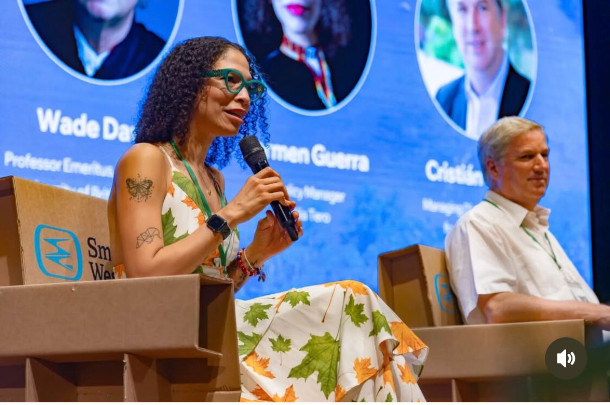
Guerra Ariza talking about indigenous knowledge during Half Earth Day at COP 16. (Photo: Courtesy of Carmen Rosa Guerra Ariza)
O'NEILL: And how do Colombia's indigenous communities protect nature and the environment?
GUERRA: Well, first, we understand that we are not protecting Mother Earth. It's on the contrary, Mother Earth is protecting us. The first message that we send in COP 16 was that. A reminder to the humanity, because, you know, humans can be really arrogant. Second, that relationship, acknowledging that allows you to recognize that you are part of the Mother Earth. So, behaving in that way, behaving in a respectful way because you are part of you are not over Mother Earth, you are part of Mother Earth. In that way, you can protect but also something that is absolutely important for every single indigenous nation that I know and for sure, for the heart of the world is the spiritual protection to Mother Earth. So, we are connected through our spiritual authorities, the Mamos and the Sakas, they are our traditional spiritual authorities that guide us and that have this deep connection with Mother Earth. Actually, they can interpret Mother Earth in showing us what is Mother Earth saying or suggesting or even advising, because Mother Earth is a living being.
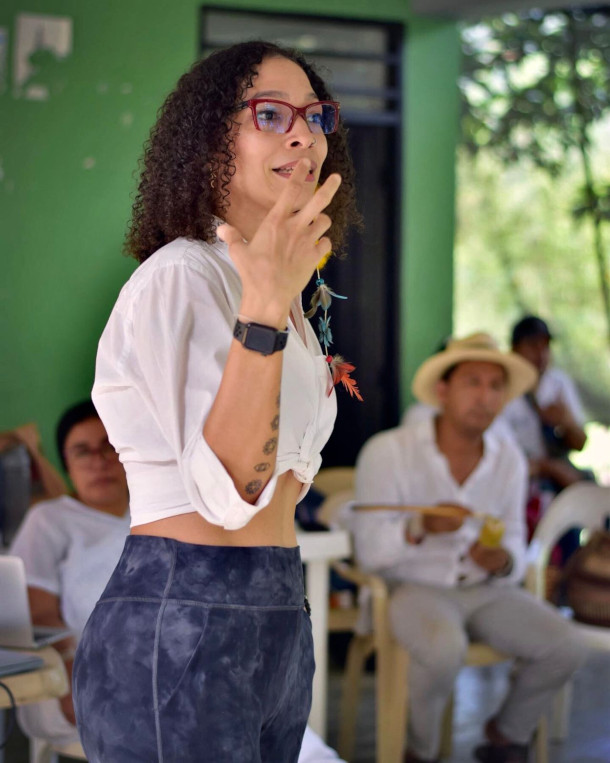
Carmen Rosa Guerra Ariza talking about COP16 to the Ponton community inside Kankuamo territory. (Photo: Courtesy of Carmen Rosa Guerra Ariza)
O'NEILL: Now you were at the recent UN biodiversity conference COP16, which was in Cali, Colombia. What role did indigenous nations have in this conference?
GUERRA: Well, first of all, for the biodiversity conference, I do feel that the indigenous movement had an strong pathway. So, since the COP 3, we have the IIFB, the International indigenous forum of biodiversity, and that build the capacity for having a caucus that actually acknowledge all the issues on biodiversity in a settled way. In our traditional system, knowledge system, is also important to generate the practical approach of the protection of what the convention of biodiversity want to achieve. At the end of the day, we are giving our life for our territories, and we are protecting key ecosystem in the whole world, in the seven sociocultural regions. So that's why our role is absolutely specific, but also important, because even the parties need to acknowledge that in every single way that the Western approach is being failing, we are having success.
O'NEILL: Carmen Rosa Guerra Ariza is the Global Agenda Coordinator of the indigenous Kankuamo organization. Thank you so much for your time with me today, Carmen.
GUERRA: Thank you so much you guys and hasay, hasay.
O’NEILL: The new formal body was created to give indigenous communities a proper seat at the table in the negotiations going forward. And in light of the lack of quorum at the end of COP16, those negotiations will continue at an interim meeting next year in Bangkok, Thailand.
Related links:
- United Nations | “COP16: Landmark Biodiversity Agreements Adopted”
- Learn more about the Kankuamo people
- UNESCO | “Ancestral System of Knowledge of the Four Indigenous Peoples, Arhuaco, Kankuamo, Kogui and Wiwa of the Sierra Nevada De Santa Marta”
- Watch a video on COP16
- Learn more about Carmen Rosa Guerra Ariza
- Learn more about Nia Tero
- The Guardian | “COP16 Ends in Disarray and Indecision Despite Biodiversity Breakthroughs”
[MUSIC: Alfredo Rolando Ortiz, Rafael Ricardo, “Quise Manchar Tu Alma” on Arpa Vallenata]
BELTRAN: Coming up, solar energy could power much of Puerto Rico, but a utility-scale project is raising concerns about community impacts and reliability. Keep listening to Living on Earth.
ANNOUNCER: Support for Living on Earth comes from Friends of Smeagull the Seagull and Smeagull’s Guide to Wildlife. It’s all about the wildlife right next door to you! That’s Smeagull, S - M - E - A - G - U - L - L, SmeagullGuide.org.
[CUTAWAY MUSIC: Oscar Peterson, “Bag’s Groove” on Work from Home with Oscar Peterson, UMG Recordings, Inc.]
BirdNote®: Great Tinamou

A Great Tinamou on the forest floor. (Photo: Aaron Maizlish, Flickr, CC BY-NC 2.0)
BELTRAN: It’s Living on Earth, I’m Paloma Beltran.
O’NEILL: And I’m Aynsley O’Neill.
[BIRDNOTE THEME]
O’NEILL: Colombia’s jungles are home to a bird with a most unusual call, Mary McCann reports in this week’s BirdNote.
BirdNote®
Great Tinamou - Eerie Voice in the Jungle
[Great Tinamou song/call: https://www.xeno-canto.org/231236]
This eerie sound can be heard in the lowland jungle throughout much of Central and South America. It’s the voice of a Great Tinamou [pronounced TIN-uh-moo]. Secretive — and almost impossible to see — Great Tinamous call early and late in the day. And their voices carry a long distance.
[Great Tinamou song/call: https://www.xeno-canto.org/231236]
Forty-seven species of tinamous live in the American tropics. They are chunky birds, with strong legs and smallish heads. Their bodies resemble those of a quail or partridge, but they’re not related. Instead, tinamous’ closest known relatives are huge, extinct, flightless birds of New Zealand.
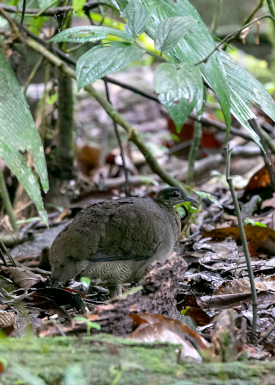
These Great Tinamous are best known for their distinctively eerie call. (Photo: Charlie Jackson, Flickr, CC BY 2.0)
Their short wings can get them off the ground for brief flights. But mostly, tinamous spend all their time on the ground, where they walk briskly and can even sprint for a short distance.
Tinamous eat plants, insects, worms, snails and small vertebrates like frogs. Males build and defend nests and tend the young, while females roam about and mate with several males. Their eggs are like highly polished jewels, ranging in color from brilliant red to yellow-green, purple, blue-green and black.
But it’s that voice that sets it apart…
[Great Tinamou song/call: https://www.xeno-canto.org/231236]
###
Written by Bob Sundstrom
Producer: John Kessler
Executive Producer: Sallie Bodie
Editor: Ashley Ahearn
Associate Producer: Ellen Blackstone
Assistant Producer: Mark Bramhill
Bird sounds courtesy of Xeno-Canto. Recorded by P. Boesman.
BirdNote’s theme was composed and played by Nancy Rumbel and John Kessler.
© 2020 BirdNote March 2020 Narrator: Mary McCann
ID# tinamou-01-2020-03-27 tinamou-01
https://www.birdnote.org/show/great-tinamou-eerie-voice-jungle
O’NEILL: If you want to put a face to that voice we’ve got pictures at the Living on Earth website, loe dot org.
Related link:
Find this story on the BirdNote® website
Puerto Rico’s Solar Power Problem
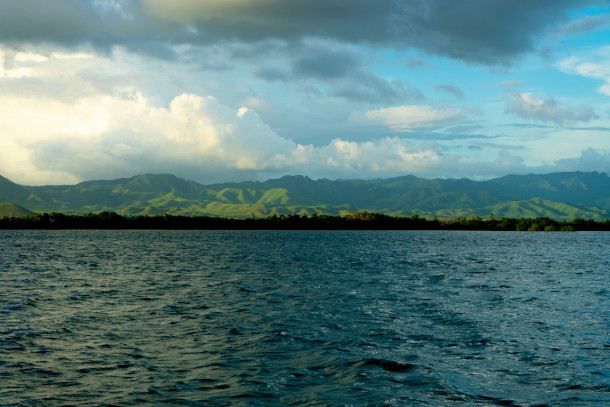
A calm body of water in Salinas, Puerto Rico, with green mountains rising in the background under a bright, clear sky. The scene showcases the natural beauty of Puerto Rico’s southern coast. (Photo: Aaron Gonzalez, Unsplash)
BELTRAN: In 2017, Hurricane Maria destroyed Puerto Rico’s power grid, leaving virtually all 3.4 million residents without electricity. Thousands of people died as a direct consequence of the hurricane, and those with health problems were left vulnerable due to a lack of refrigeration, dialysis care, food, and air conditioning, leading to even more deaths. The island has set a goal of using only renewable energy by 2050, and as it transitions away from the fossil fuels that currently supply 90% of its energy, reliability is a key concern. The Department of Energy recently announced an $860 million dollar loan for two industrial-scale solar projects meant to provide 200 megawatts of solar energy capacity yearly, enough to power 43,000 homes. This development, known as “Project Marahu,” is expected to be the largest solar and battery storage installation in Puerto Rico. The project will be led by Clean Flexible Energy LLC an indirect subsidiary of both the U.S.-based AES Corporation and Total Energies Holdings USA Incorporated. AES has been under scrutiny for its management of a 450-megawatt coal plant located in the south coast next to the communities of Salinas and Guayama. Ruth Santiago, an environmental attorney who lives in Salinas, is a member of the White House Environmental Justice Advisory Council, and board member of We Want Sun or Queremos Sol. She is here to share her concerns about this project and what she sees as the future of solar energy in Puerto Rico. Ruth, welcome back to Living on Earth!
SANTIAGO: Thank you. Hi, Paloma. Nice to be here again.
BELTRAN: Could you walk us through the details of the AES industrial scale solar project planned for Salinas and Guayama? What makes this project different from other solar initiatives?
SANTIAGO: Okay, so AES Corporation has a subsidiary and affiliate here in Puerto Rico, specifically in Guayama, Puerto Rico, here in southeastern PR, that runs a coal fired power plant since 2002. And they have been in violation of the Clean Air Act, the Clean Water Act, the Resource Conservation and Recovery Act with respect to the operation of the coal plant, because... Especially because of the mismanagement of the coal ash waste that the plant operates. And now AES is saying that they are going to close the coal plant. By law, they have to close by the end of 2027, and they want to build the largest solar installations in Puerto Rico, nearby their current operations, but also here in Salinas, extend into the neighboring municipality of Guayama.
BELTRAN: And can you describe to us the area of Salinas and Guayama, where this project will be located, who lives there and what kind of biodiversity can be found there?
SANTIAGO: The area is an agricultural area, also an area of huge ecologic value, very close to the Jobos Bay, and what is known as the Jobos Bay National Estuarine Research Reserve, designated by the National Oceanic and Atmospheric Administration, the federal agency known as NOAA. There's a combination of agricultural value, prime agricultural land, and also ecological value at this site. So pursuant to the studies that AES was required to do, they found that some of the areas where these proposed modules, it's like over 280,000 solar modules, that they are habitats for various protected species, like the yellow shouldered black bird, and for the Puerto Rican boa. It's local species of the boa, a snake, and also there is a species of lizards that are protected that were found in the area as well.
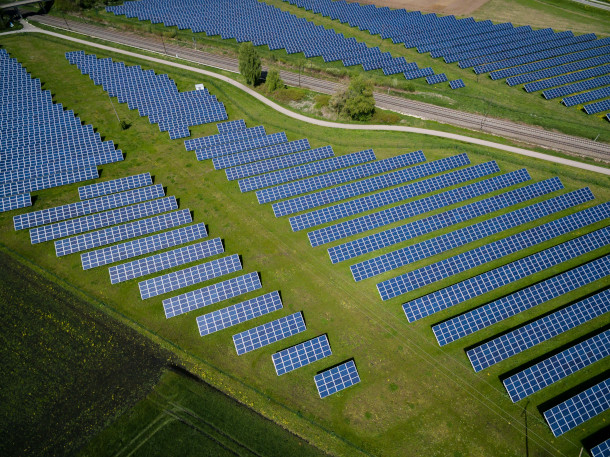
An industrial-scale solar plant in Offingen, Germany, with rows of solar panels covering the landscape, emphasizing the large-scale, industrial nature of the project. (Photo: Andreas Gücklhorn, Unsplash)
BELTRAN: So, there’s been a few studies monitoring how the AES solar projects will have a significant impact on local communities and ecosystems. Could you tell us more about that research, who has been involved in conducting these studies?
SANTIAGO: So, we have a couple of those. One of them is a hydrological study about the huge tract of land where the AES, what they call the Salina solar project, would be built. That's one of the studies, another study by a geologist indicates that the proposed projects are in seismic zone, active seismic zones. So, the only thing that divides this tract of land from the nearby community is a road. Directly south of that are some of the poorest communities with high poverty levels, high percentage of Afro descendant communities, formerly... A lot of former sugar cane workers and otherwise underserved communities lacking educational services, hospital and medical services. So, it's, in general, very vulnerable communities that are already exposed to some level of flooding. The Salinas, in general, is a highly flood prone area, right? And so, they do get some flooding now, that would increase with, you know, further construction, elimination of vegetation and stormwater discharges north of, of their areas.
BELTRAN: And, Ruth, you've form part of a coalition of organizations called Queremos Sol and advocate for solar energy in the island of Puerto Rico. To your knowledge, is there an area of the island that will be better fit for the type of project that AES is carrying forward right now?
SANTIAGO: According to most of the studies, really points towards using the built environment to place these solar panels, and there are lots of benefits to doing that. You don't sacrifice land, you don't sacrifice ecosystems, you don't expose nearby communities to more flooding. You increase the property values where these panels are sited. You actually protect the properties, and it allows for more energy security, right, when people have those panels on their rooftops or nearby in parking lots or in very close to the point of use, both for people and businesses and institutions. One of the other problems with these utility scale, industrial scale solar installations, is that they depend heavily on poles and towers and lines and wires and substations that are frequently impacted by hurricanes, by storms, by flooding, by vegetation growth, by wildlife impacts. So, energy generation that depends on transmission, especially like the solar arrays, have double vulnerability, let's say.
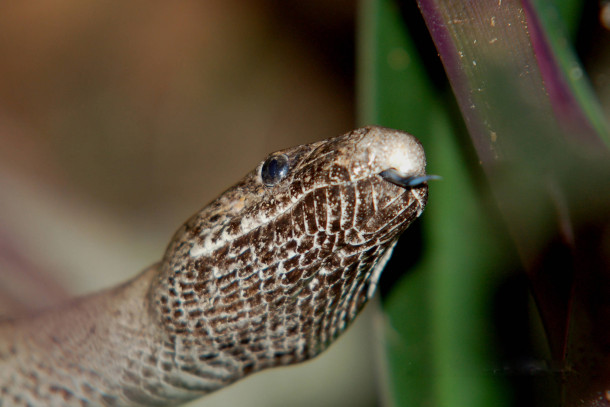
The Puerto Rico boa (Epicrates inornatus), an endangered species, inhabits the area where the solar project is planned, raising concerns about the impact of the development on this critical habitat. (Photo: Jan P. Zegarra, USFWS, Flickr, Public Domain)
BELTRAN: Now, of course, we've been talking about an industrial scale solar plant, but what are some examples of decentralized rooftop solar projects across the island?
SANTIAGO: So, the first that I know of was the Adjuntas Casa Pueblo in that town in the central, mountainous area of Puerto Rico, and it was, I think, the first initiative to branch out in that way. First, to start with their center, right, the Casa Pueblo headquarters or offices, and then branch out into nearby communities and small businesses, and then to their town center. And then, subsequently, other community environmental groups throughout Puerto Rico are doing the same, including here in Salinas and Guayama, where Comité Dialogo Ambiental and other groups are implementing rooftop solar projects, mostly for residential users.
BELTRAN: Now, looking at Puerto Rico's renewable energy goals, how do you envision a just transition? What would a fair approach to energy transition look like for communities in Puerto Rico?
SANTIAGO: Yeah, I think for communities, what's needed is a just transformation, because we need to consider things other than just carbon emissions or CO pollutant emissions. We need to consider resilience, for example, and on site, rooftop solar provides resilience that industrial scale solar projects can't provide. We saw after Hurricane Maria that the solar installations that existed at the time took about 15 months to be able to reconnect to the grid and generate at capacity, about 15 months without being able to supply energy to anyone. That would not happen if the energy were being provided by rooftop solar, obviously.
BELTRAN: So, Luma energy has been the primary energy distribution company in Puerto Rico for a few years now. What's been their relationship to renewable energy, or solar energy projects in the island?
SANTIAGO: They operate the transmission and distribution system, not the plants, although they do decide which plants sort of get to inject power into the grid. What Luma has done in terms of renewables is sort of conditionally approved integration of distributed renewable energy but charging people like extra for certain studies that are repetitive with respect to the linkage to, or interconnection with the system. But, because of these more frequent, more prolonged power outages, people who can afford it, higher income people, or people who have huge tolerance for high debt, have incurred, you know, and entered into these lease agreements that are like a second mortgage, is how people describe them. And of course, most of the population can’t afford that, right? So, right now, only about 8 or 9% of people, households, have rooftop solar with these private companies like Sonova, and the other 90+ percent is basically reliant on this centralized energy grid that fails frequently, whether through outages or with voltage fluctuations that damage household equipment, hospital equipment, etc.
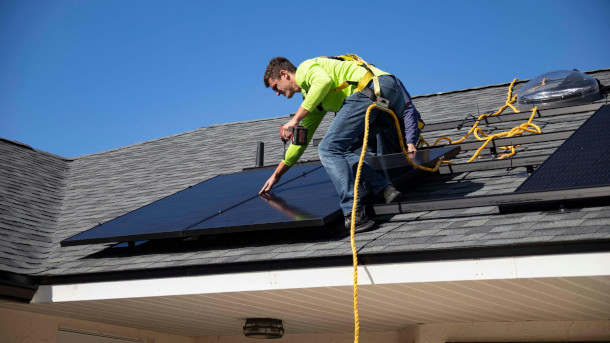
Solar panels can be installed on rooftops, utilizing the built environment for clean energy generation without compromising valuable natural areas. (Picture: Raze Solar, on Unsplash)
BELTRAN: Now, looking ahead, what would you like to see from both the government and energy companies when it comes to supporting Puerto Rican communities in their advocacy for clean and equitable energy solutions?
SANTIAGO: The government, in order to facilitate an equitable system, right, is required, really, to use the historic amount of disaster recovery and mitigation funding that is over $19 billion, with a B, to provide real energy security and direct public funding for rooftop solar, energy efficiency, demand response, energy literacy programs, so that communities can become producers, not just passive consumers of energy, can provide at least their critical household needs, business needs, institutional needs, and continue to operate even after a big storm or hurricane. It's important to emphasize that like even just this year we had the storm Ernesto, and there was a power outage, and we heard about excess deaths again. And we really need to get the federal government and people in the states to get behind these agencies, the Department of Energy, the FEMA, the Army Corps of Engineers, to realize that Puerto Rico does not need to be a place of unmitigated disaster, that we can have a very viable electric system that provides energy security and allows for this to be a livable place, basically, where people can live and work and otherwise prosper.

Ruth Santiago is a community and environment lawyer, as well as a member of the White House Environmental Justice Advisory Council. (Photo: Courtesy of Ruth Santiago)
BELTRAN: Ruth Santiago is a community and environmental lawyer as well as a member of the White House Environmental Justice Advisory Council. Thank you so much for joining us.
SANTIAGO: Thank you. Thanks for the opportunity to be on with you in this conversation.
BELTRAN: We reached out multiple times to AES; the company developing the utility solar project and did not receive a response. A U.S. Department of Energy spokesperson did provide this statement: “As with all LPO (Loan Programs Office) projects that successfully close a loan, Project Marahu complies with the National Environmental Policy Act. This project will play an integral role in increasing Puerto Ricans’ access to reliable and affordable energy, while also creating jobs, improving grid reliability, and helping Puerto Rico reach its goal of 100% renewable energy by 2050.”
Related links:
- Learn about the Queremos Sol initiative advocating for community-driven renewable energy solutions in Puerto Rico
- Discover Casa Pueblo’s innovative rooftop solar project in Adjuntas, supporting energy independence and resilience
- Read about the $860 million Department of Energy loan for Project Marahu, aimed at expanding solar and battery storage capacity in Puerto Rico
- Learn more about the environmental and health impacts of coal ash disposal in Puerto Rico, and efforts to address these issues
[MUSIC: Pedro Guzman, “Primogenito” on Jibaro Jazz, Cuatro Sound]
O’NEILL: Living on Earth is produced by the World Media Foundation. Our crew includes Naomi Arenberg, Kayla Bradley, Josh Croom, Jenni Doering, Daniela Faria, “Mehek” Gagneja, Swayam Gagneja, Mark Kausch, Mark Seth Lender, Don Lyman, Nana Mohammed, Sophia Pandelidis, Jake Rego, Andrew Skerritt, and El Wilson.
BELTRAN: Tom Tiger engineered our show. Allison Lirish Dean composed our themes. You can hear us anytime at L-O-E dot org, Apple Podcasts and YouTube Music, and like us, please, on our Facebook page - Living on Earth. We tweet from @livingonearth. And find us on Instagram at livingonearthradio. And we always welcome your feedback at comments at loe dot org. Steve Curwood is our Executive Producer. I’m Paloma Beltran.
O’NEILL: And I’m Aynsley O’Neill. Thanks for listening!
ANNOUNCER: Funding for Living on Earth comes from you, our listeners, and from the University of Massachusetts, Boston, in association with its School for the Environment, developing the next generation of environmental leaders. And from the Grantham Foundation for the protection of the environment, supporting strategic communications and collaboration in solving the world’s most pressing environmental problems.
ANNOUNCER 2: PRX.
Living on Earth wants to hear from you!
Living on Earth
62 Calef Highway, Suite 212
Lee, NH 03861
Telephone: 617-287-4121
E-mail: comments@loe.org
Newsletter [Click here]
Donate to Living on Earth!
Living on Earth is an independent media program and relies entirely on contributions from listeners and institutions supporting public service. Please donate now to preserve an independent environmental voice.
NewsletterLiving on Earth offers a weekly delivery of the show's rundown to your mailbox. Sign up for our newsletter today!
 Sailors For The Sea: Be the change you want to sea.
Sailors For The Sea: Be the change you want to sea.
 The Grantham Foundation for the Protection of the Environment: Committed to protecting and improving the health of the global environment.
The Grantham Foundation for the Protection of the Environment: Committed to protecting and improving the health of the global environment.
 Contribute to Living on Earth and receive, as our gift to you, an archival print of one of Mark Seth Lender's extraordinary wildlife photographs. Follow the link to see Mark's current collection of photographs.
Contribute to Living on Earth and receive, as our gift to you, an archival print of one of Mark Seth Lender's extraordinary wildlife photographs. Follow the link to see Mark's current collection of photographs.
 Buy a signed copy of Mark Seth Lender's book Smeagull the Seagull & support Living on Earth
Buy a signed copy of Mark Seth Lender's book Smeagull the Seagull & support Living on Earth

